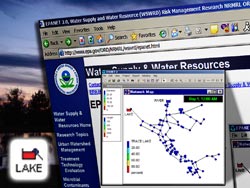EPANET Extended to Include Multi-Species Modeling
From the EPA web site:
EPANET is used in homeland security research to model contamination threats to water systems. Historically, EPANET has been limited to tracking the dynamics of a single chemical transported through a network of pipes and storage tanks. EPANET did not consider interactions between bulk species in the water or the surface species fixed to the pipe wall.

Recently, the NHSRC released a research version of MS-EPANET (Multi-Species EPANET) that allows for the consideration of multiple interacting species in the bulk flow and on the pipe walls. The multi-species modeling extensions to EPANET include the following:
- The capability to model multi-species reactions in pipes and tanks when reactions involve bulk and surface species reactions.
- Modification of the EPANET input file format to enable it to read water quality dynamics expressions and to accommodate various other multi-specie interactions. This allows arbitrary mathematical expressions of reaction dynamics. The model then parses the expressions and stores and structures the data for efficient evaluation.
- The extension incorporates Newton-Raphson and Runge-Kutta algorithms into its water quality modules to solve the differential-algebraic equations that describe the reaction dynamics.
- Modification of the EPANET Programmer’s Toolkit to allow for specification of contaminant sources and qualities.
MS-EPANET will enable users to model free chlorine loss, the formation of disinfection byproducts, nitrification dynamics, disinfectant residuals, and adsorption on pipe walls. Homeland security researchers are particularly interested in modeling the fate and transport of contaminant threats in drinking water distribution systems.
The MS-EPANET software and Userג€™s Guide is now available to researchers and consultants as part of a beta-testing program. The Userג€™s Guide includes several example applications. By the end of 2006, a tested version of MS-EPANET will be freely available.
I am teaching water supply in our Institute (Environmental Engineering & Resources at the Technical University of Denmark). I am very interested in gettting access to the expanded features in EPANET instead of doing the programming myself.
Regards,
Erik Arvin,
Water Supply Engineering
SO do I, When i can get a last version of EPANET 3.0
I work in National Water supply of Nicaragua and i´m very interesting in using.